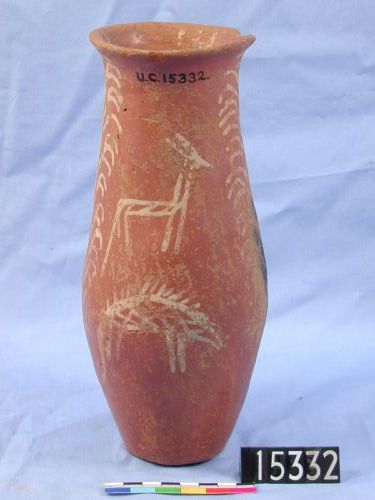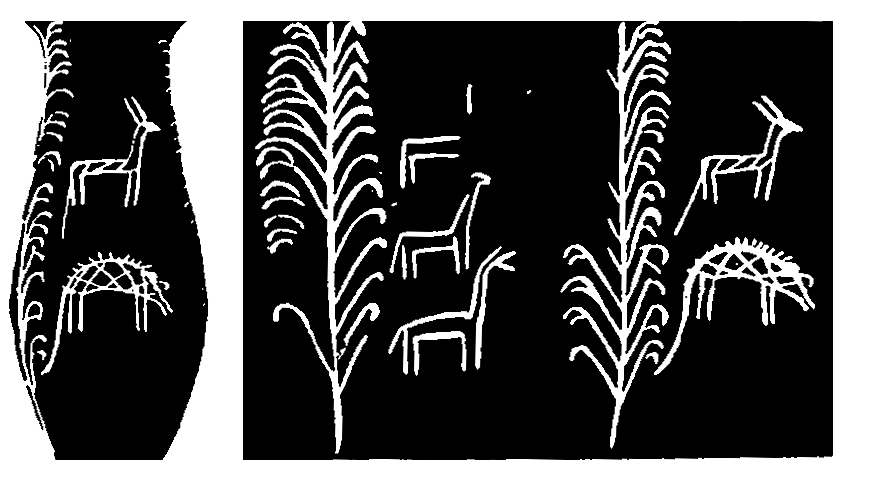C-Ware – bottle C-0432
By Droux, Xavier
Archaeological site unknown
London, Petrie Museum, UC 15332.
Date : Naqada IA–IIB
General range of C-ware production
Material : Nile silt (Painted)
Preservation : Almost complete
Decoration preservation : Partly lost
Preservation information :
Chip at rim. The surface is quite abraded in parts.
Description
A large, blackened area on one side is likely the result of the vessel being in contact with another element during the firing process. Inside the rim, only the upper part of the lip is slipped and polished.
Decoration
Two long, vertical plants, placed on opposite sides of the vessel, occupy the entire height: they conist of a stem with long leaves on both sides; each leaf first raises up before branching into two parts, each of which curves down. These plants divide the decorative space in two halves; on one side stand two quadrupeds. The one at the bottom has an elongated, narrow head, a stongly curved back with a series of small ticks along its edge - possibly indicating (raised) hair - and a long tail that extends below the bottom of its legs. Its body is crosshatched. It is difficult to ascertain the intended species, but hyena has been suggested. The animal above is slender, with a long neck and has two straight horns (or ears) that point backwards. It may be an antelope species or possibly a donkey, although the ears of the latter usually point frontwards. The tail of this animal is also unusually long, but straighter than that of the animal below. Its body is decorated with simple hatching.
On the opposite side, three animals are painted above one another; they are poorly preserved, and it is difficult to know if the same species was intended for all of them; they have slender bodies and long necks, and may also represent antelope species or donkeys. The lowermost animals has its two horns or ears preserved: they point frontwards, which seems to support the identification as a donkey. The tails of two of these animals are shorter than those observed on the animals depicted on the opposite side; the tail of the upermost quadruped is not preserved.
On the inside, the lip is decorated with four groups of three parallel oblique lines.
Dimensions (cm)
23
Additional information
Closed
flat base
Outside and inside lip
References
1905
Primitive art in Egypt; translated from the revised and augmented original edition. London
, 111, fig.83 (centre).1920
Prehistoric Egypt. British School of Archaeology in Egypt & Egyptian Research Account, twenty-third year, 1917. London
, pl. XVII, 67.1921
Corpus of prehistoric pottery and palettes. British School of Archaeology in Egypt & Egyptian Research Account 32, 23rd year, 1917. London
, pl. XXV, 98N.1952
Manuel d'archéologie égyptienne I: 1; les époques de formation, la préhistoire. Paris
, 267, fig. 171; 271, fig. 173.2001
The iconography of the hyena in ancient Egyptian art. Mitteilungen des Deutschen Archäologischen Instituts, Abteilung Kairo 57
, 129.2003
Peut-être deux nouvelles représentations d'Oryctérope sur un vase nagadien du British Museum. Göttinger Miszellen 197
, 37.2005
The Petrie Museum's beaker UC15332 or the first representation of a Hyaena hyaena in Egypt. Göttinger Miszellen 206
.2007
Les représentations prédynastiques d'oryctéropes, in: Goyon, Jean-Claude; Cardin, Christine (eds), Proceedings of the Ninth International Congress of Egyptologists. Orientalia Lovaniensia Analecta 150. Leuven
, 832, pl. II D.


